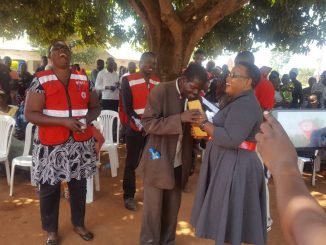
The frequent rate of mudslide disasters in Bududa and generally the Mount Elgon region has put the government and district authorities under scrutiny.
The Disaster Preparedness Ministry and District authorities have always been ill-prepared in disaster management especially Disaster Risk Reduction as per the National Policy for Disaster Preparedness and Management 2011.
The mudslides in Bukalasi last Thursday lead to 40 deaths, 15 causalities with 15 others missing according to Uganda Red Cross Society.
Structures like District Disaster Management Committee chaired by the district Chief Administrative Officer (CAO) have resurfaced after disasters have occurred. The District Disaster Management Committee (DDMC) is created as a result of Disaster Risk Reduction (DRR)
The recent mudslides in Bududa just like the one in Nametsi 2010, the Bumwalukani one in 2012 and the one in Sironoko in 2017 have been identified as a result of failure to conduct enough Disaster Risk Reduction.
Disaster Risk Reduction (DRR) has been internationally been adopted as a practice of stopping or reducing disasters from happening. The sixth schedule of the 1995 constitution vests the responsibility of disaster preparedness and management in the state.
Disasters are in different making according to the National Policy for Disaster Preparedness and Management 2011. The policy lists natural hazards in Uganda, drought, famine, food insecurity, floods, landslides, mudslides and earthquakes, environmental degradation among others as possible disaster in Uganda.
The policy’s mission is to create an effective framework through which Disaster Preparedness and Management is entrenched in all aspects of development processes, focusing on saving lives, livelihoods and the country’s resources.
The disaster formula in Uganda has been defined as Risk is Equal to Hazard times the vulnerability or how vulnerable a person or a place is to that hazard. That formula is measured against an individual, local community, district or the national level’s capability to manage that risk.
In Bududa, and the Mount Elgon area, the local and national authorities should have understood how to reduce the risk by for example evacuating the population at risk so that they don’t die. The other option would have been an early warning mechanism to warn the population at risk.
After the after the 2010 mudslides in Nametsi, Bududa district developed flood warning mechanism. Wooden flood warning stumps marked with different levels gauges were placed in Suume river running all the way from Shiwandu, Bukalasi, Nanyinza through Bubiita, Bukigai and Malandu towards Manafa.
The stamps from eucalyptus timber would soon get rotten leaving the potential victims with no warning at all.
The residents in Nametsi, Bukalasi, Nanyinza, Maduramu, Buwali, Buwanyanga, Bunetibo, Bubiita and Suume villages have hardly been taken trough drills preparing for possible mudslide disasters yet all the mudslide disasters in Bududa happen after a day or two days of constant rains.
Experts in Disaster Preparedness or Disaster Risk Reduction point to failure on the part of the individuals, Bududa District Disaster Management Committee and the Disaster Preparedness Ministry.
An expert knowledgeable about disaster in the Office of Prime Minister agreed that there was failure at all levels. The expert that asked for anonymity told this publication that there should have been a mandatory excavation call as part of the late stage in disaster risk reduction.
The expert said disaster management involves preparing, supporting, and rebuilding society when natural or man-made disasters occur.
That emergency management depends highly upon the local economic and social conditions within the disaster region and involves four phases: mitigation, preparedness, response, and recovery.
This publication previously interviewed late Major General Julius Oketta (RIP) the then Director of National Emergency Coordination and Operations, in the Office of the Prime Minister. After the 2012 Bumuwalukani mudslides. He was of the view that 15 villages of Bududa should have been evacuated.
But many more have died and will continue to die because the Disaster Management plan remains talks than action.
General Oketta and his team had suggested relocating communities locate in risky hilly areas to safer valleys so that those with cultural attachments would remain Bududa.
Efforts to relocate the vulnerable communities to safe areas like Bulambuli have been slow with some “well-connected” individual seeking to cash in from the process.
Uganda Media Centre Executive Director, Ofwono Opondo while appearing on this publication partner’s Capital Gang said the plans to relocate some of the people to Bulambuli was being hammered by budgetary constraints.
Ofwono said some individuals in parliament have ensured that the Ministry of disaster is not allocated funds for purchasing land in Bulambuli. He cited the deputy Chairperson Budget committee parliament though he did not mention his name. But this publication has learnt that the Deputy Chair of Parliament’s Budget Committee is from Bulambuli.
President Museveni while in Bukalasi Sub County apologised over his government’s failure to relocate residents from the risky slopes to safer areas.
Mr. Museveni said the relocation had been delayed by politicization of the matter. President Museveni promised to give five million shillings to families of each person that died in the mudslides and two million shillings to the injured.
But those knowledgeable about disaster management and response told this publication that the President needs to plan any action based on the national disaster policy 2011.
That responding according to the plan would not address the immediate impact of the disaster but also guide recovery and reconstruction effectively.
Read Also: Mount Elgon disasters need action, not talk
This publication was in Nametsi in April this year. It was evident that a fire fighting-like method rather than social process had been used to respond to that particular disaster and the subsequent ones it was like “Put off the fire and go” as George Namatati one of the survivors of the 2010 mudslides puts it.
Namatati and many others opted not to relocate to Kiryandongo. Others who had been resettled to Kiryandongo returned to Nametsi.
They have reclaimed the land in which their relatives perished. Many are aware of the risk but would rather stay in Bududa. Besides, those that were relocated to Kiryandongo did not return with good stories to encourage George Namatati and others to move to Kiryandongo too.
Nametsi has eight years after the disaster not undergone any form of recovery and reconstruction. Accessibility to the area is still difficult as it was in 2010.
Nametsi has not gone through any form of revival through rebuilding basic facilities, such as schools, roads and amenities. The livelihoods and the local economy has not been rebuilt.
State Minister for Environment, Dr. Gorret Kitutu has in the past offered a lasting solution to the Mount Elgon crisis suggesting proper using the environment approach.
But the solutions have remained on paper and talk. Mount Elgon doesn’t have time for mere tall or political theatrics with many deaths each year from mudslide disasters.
– URN



